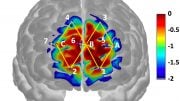
New research discovered individual variability in gamma oscillations in the brain, previously thought to represent pain perception. This study found these brain waves are consistent within individuals but vary widely across individuals, leading the researchers to suggest a need for revisiting past research methodologies.
A recent study has uncovered that each individual possesses a unique ‘pain fingerprint’ in their brain, which can vary significantly from one person to another. Led by the University of Essex, in partnership with the Ludwig Maximilians University of Munich’s neuroscience of pain group, the research identified that the rapid oscillations in brain waves associated with brief pain and touch can differ widely in scans.
Historically, these waves, known as gamma oscillations, were believed to represent pain perception in the brain. However, earlier research primarily centered on collective data, often neglecting the variances observed between individuals and sometimes even dismissing these disparities as mere ‘noise’ in the scans.
The Department of Psychology’s Dr. Elia Valentini found major differences in timing, frequency, and location of the gamma oscillations and incredibly some people showed no waves at all.

An example of a gamma oscillation brain pain fingerprint. Credit: University of Essex
Dr Valentini said: “Not only, for the first time, can we pinpoint the extreme variability in the gamma response across individuals, but we also show that the individual response pattern is stable across time. This pattern of group variability and individual stability may apply to other brain responses, and characterizing it may allow us to identify individual pain fingerprints in the activity of the brain.”
The study, published in the Journal of Neurophysiology, was able to map patterns in participants from another lab, suggesting a replicable phenomenon.
In total, data from 70 people were examined. The experiments were split into two studies with a laser used to generate pain. Overall, it was discovered that the subject’s gamma waves were “remarkably stable” and created similar individual patterns when stimulated.
Interestingly, some recorded feeling pain and having no gamma response, whilst others had a large response.

Another gamma oscillation showing the person-to-person difference. Credit: University of Essex
At this stage, it is not known why there is such variation – but it is hoped this will be a springboard for future research.
Dr Valentini added: “I think we need to go back to square one because past findings on the relationship between pain and gamma oscillations do not represent all the participants. Unfortunately, this minority can drive the research results and lead to misleading conclusions about the functional significance of these responses. We don’t mean for gamma oscillations not to have a role in pain perception, but we certainly won’t find its true role if we keep quantifying it as we did thus far.”
Dr. Valentini hopes this study will also change the way gamma oscillations are measured in other sensory domains.
Reference: “Interindividual variability and individual stability of pain- and touch-related neuronal gamma oscillations” by Elia Valentini, Alina Shindy, Viktor Witkovsky, Anne Stankewitz and Enrico Schulz, 6 June 2023, Journal of Neurophysiology.
DOI: 10.1152/jn.00530.2021









Be the first to comment on "New Research Uncovers That Everyone’s Brain Has a Unique “Pain Fingerprint”"